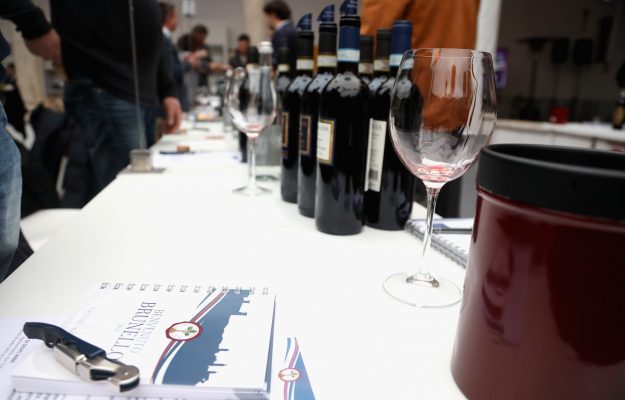A “wine” turnover of 160 million, which comes from 3,500hectares of vineyards, of which 2,100 Brunello di Montalcino (whose values, according to estimates WineNews, are around 750,000 euros per hectare, with peaks of 900.000 for the best vineyards), and an export that covers 70% of production and turnover, the most precious of the wines of Tuscany and Italy (with a value of bulk permanently above 1,200 euros per hectolitre), saw the debut today at Benvenuto Brunello 2019, the vintage 2014 and the Riserva 2013.
A “small” vintage, 2014, as would be said by the French, in some cases perhaps “very small”, confirming that even in Montalcino the impact of the quality of the vintage, despite the rejuvenation and prolonged aging in the cellar, weighs significantly. 2014 has the flavor of the late 1970s and early 1980s harvests when the grapes arrived in the winery in the last ten days of October.
The high acidity of the grapes and slow maturation, when reached, has yielded after five years of wood wines with scents of good clarity and fragrance, but a gustatory progression of short breath, with tannins in many cases too marked.
Good sensations in the aromas of Brunello di Montalcino 2014 by Baricci, with a strong and intense taste. The Brunello di Montalcino 2014 di Caparzo is modern and well made, while the nose of the Brunello di Montalcino 2014 di Cava d’Onice is smoky and floral, reactive and intriguing in the mouth.
One of the best is Corte dei Venti’s Brunello di Montalcino 2014 with a nose of flowers and fruits and a gritty and savory taste. A personal stylistic trait in Fattoi’s Brunello di Montalcino 2014, with flint scents and incisive and continuous development. The Brunello di Montalcino 2014 by Gianni Brunelli - Le Chiuse di Sotto is elegant and well-defined, while the Brunello di Montalcino 2014 by Greppone Mazzi (Ruffino) has a modern, well-executed style.
Delicious, but it is not the first time, the Brunello di Montalcino 2014 of Pietroso, while the Brunello di Montalcino 2014 of Il Marroneto stands out with its fine tannins and fragrant and decisive scents. The Brunello di Montalcino 2014 di Palazzo is pleasant to the nose and delicious in the mouth, while the Brunello di Montalcino 2014 di Poggio di Sotto is very full-bodied but with a savory and gritty taste.
Among those who have given up the production of Brunello, given the criticality of the year, stands out the beautiful Rosso di Montalcino 2016 de Le Ragnaie, with elegant aromatic traits with a flavor evolution. Also interesting is the Rosso di Montalcino 2017 di Salvioni, with its flourishing fruit and fleshy and intense sip. Another step for the 2013 Riserva, which confirms the excellent sensations of the vintage, already experienced at last year’s Benvenuto Brunello.
Interesting Brunello Phenomena Riserva 2013 of Sesti with fine and incisive aromatic traits and a full and complex gustative development. Very good the Brunello Due Lecci Est Riserva 2013 of the Tenuta di Sesta involving in its aromas and fragrant in taste. Among the most traditional wines, the Brunello di Montalcino Vigna Soccorso Riserva 2013 by Tiezzi, while the Brunello Spuntali Riserva 2013 of Val Di Suga (Bertani Domains) finds strength and territorial coherence, a little lost in the past. The Brunello di Montalcino Pianrosso Riserva 2013 by Ciacci Piccolomini d’Aragona is a success, revealing a fruity and floral nose and an intense taste. The Brunello di Montalcino Ugolaia Riserva 2013 by Lisini is a great, well-defined body, full and continuous on the palate and very fruity on the nose. The Brunello di Montalcino Vigna Schiena d’Asino Riserva 2013 by Mastrojanni is definitely a great wine.
This is the picture that emerges from the glass test for Brunello di Montalcino, one of the most prestigious wines in the consumer’s perception. According to a Nomisma survey, in fact, 35% of consumers associate it with the concept of “excellent quality”, 25% with “luxury”, 21% with “tradition and classicism”. A special occasion wine, Brunello, which most consumers (44%) between 18 and 65 years of age drink 2-3 times a month, or even more rarely (although there is a 34.7% that has not consumed it at all in the last year).
Copyright © 2000/2025
Contatti: info@winenews.it
Seguici anche su Twitter: @WineNewsIt
Seguici anche su Facebook: @winenewsit
Questo articolo è tratto dall'archivio di WineNews - Tutti i diritti riservati - Copyright © 2000/2025









































































































































































































